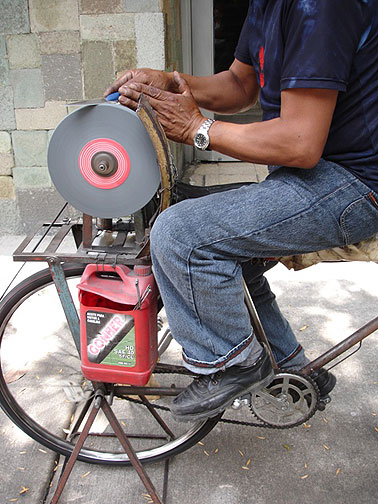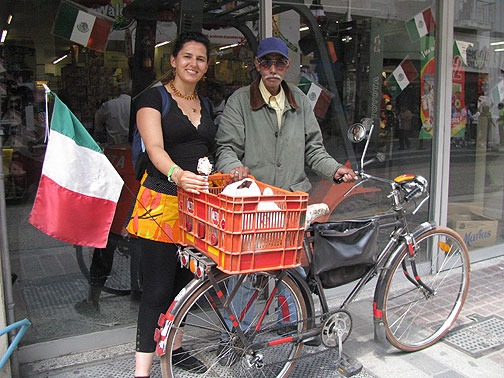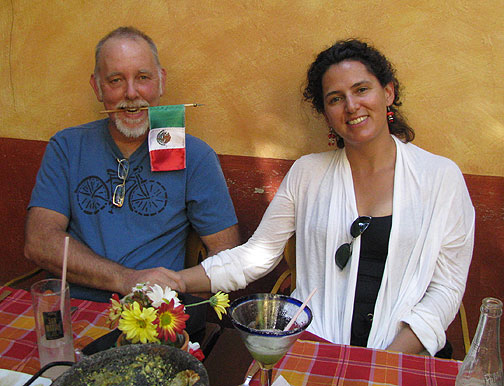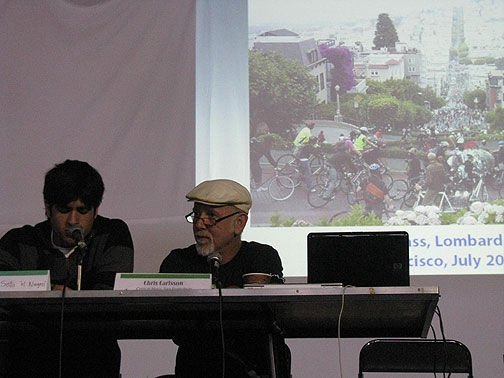Recent Posts
-
Yes, There IS a Future!
December 26, 2025
-
Real Crimes and the Coming Violence
September 6, 2025
-
Whither Modern Life?
June 27, 2025
-
What the Hell
June 18, 2025
-
As Darkness Engulfs Us
April 6, 2025
-
AI, Risk, and Work
January 17, 2025
-
“Things Are in the Saddle, and Ride Mankind”
December 29, 2024
-
Forgotten Futures in Seattle
December 12, 2024
-
Autocracy Defeats Neoliberalism
November 14, 2024
-
History… We’re Soaking in It!
October 2, 2024
|
I’m happy to welcome my media naranja, Adriana Camarena, as a guest blogger. This is her first but I hope not last contribution to The Nowtopian!
When I think of bicycles in Mexico beautiful images of workers spring to mind. Delivery men flutter on the streets on two or three wheels pollinating the neighborhoods with water, bread, telegrams, mail, newspapers, flowers, pharmacy errands, tacos de canasta, and other daily comforts. The factory workers also arrive on their bicycles. The films of the Golden Age of Mexican Cinema — often in the same category as cult Mexican films — nurtured the national imagination with an abundance of characters on bicycle. Pedro Infante -““ a legendary Mexican singer and actor of that era — in a biographical film about his life is depicted as a humble bicycle mechanic in his beginnings. Among my favorite cast of characters on bicycle is the knife sharpener. He blows a sharp whistle as he rides through the street, telling his clients that he is available. When I lived in Mexico City, many times I called out from my top window “I’ll be right out!” El Afilador de Cuchillos places his back wheel on a stand. He sits and peddles backwards on his bike to whirl the sharpening stone; sparks fly to give knives a new edge. For more than a century, such workers have peddled the streets of Mexico. Even in the most populated cities of Mexico, the flowers, the bread, the water, the news, the mail, still arrive on bicycle.
 Knife sharpening on the streets of Mexico with a bicycle-based machine. 
On Saturday, September 19th 2009, Chris and I wandered the pedestrian zones of the historical colonial center of Guadalajara during the lunch hour, here known as la hora de la comida or la hora de la siesta. La hora lasts about two hours. We spent the hour eating pistachio and prune ice paletas, while window shopping, buying a wooden spatula on the street, and people watching; I even tried on a sparkly Quinceañera crown made of silver and crystals because it was rather remarkable. In other words, we were making time before the afternoon conferences of the second day of the Second Annual National Cycling Conference. (I say making time, because while English speakers “kill time” whenever they have a surplus of time on their hand before an event, we Spanish speakers say we are haciendo tiempo: making time.)
While we wander around, making time, I see an elder gentleman with his bicycle in front of a pharmacy. I shamelessly ask him “Disculpe, señor, are you a messenger?” Messengers are on my mind. Later that afternoon, we will attend a conference delivered by a panel of bike messengers.
Well, this is my own purchase, right now”, he says pointing to a bag in the crate on the back of his bike, “But, I am a messenger in everyday life. “¦ Once upon a time, I delivered telegrams.”
 Adriana and Don Francisco Gonzalez Estrada with his 1957 bicycle. We have a conversation, and part ways. Chris and I retrace our steps to the Museo de la Ciudad to attend the Bicycle Messenger Talk headed by bike messenger Jimmy Lazima from Los Angeles, California, one young bike messenger from Ciudad Guzman, Jalisco, and fixie bike aficionados from Guadalajara. Jimmy engages the audience with stories about riding and working through gridlocked Los Angeles streets. The Mexican messenger talks about his on-going and painstaking efforts to set-up business, create a clientele basis, and promote ecological culture in Ciudad Guzman without yet being able to make a living from his efforts.
Continue reading New Generation Meets Iconic Bicycle Messenger
Tag this one as fine whine…
Mexicana airlines is probably among the world’s worst. I’ve had my bad experiences with them in the past, but this trip to Guadalajara has reached a new depth. It all started back in April when I was invited to speak at the 2nd Annual Mexican Cycling Congress in Guadalajara. They kindly offered to cover my airfare, which was handled by a sponsor with lots of frequent flyer miles on Mexicana (their program is known as “Frecuenta”). I was excited since Adriana’s family is mostly in Guadalajara, so she made plans to join me, using some of her surplus of Frecuenta miles to cover her airfare. We had our flights arranged, flying down on the last day of April, going to the conference and then flying home about 10 days later from Mexico City where we planned to go overland…
That’s when the fun started. The Big Flu Scare caused the conference to be postponed, so the tickets were put on hold, pending the new dates. Eventually, after many calls, our friends in Guadalajara got my ticket rescheduled for this trip. The problem is, now we didn’t want to go Mexico City ten days later. We wanted to go home after a week in Guadalajara. The ticket was switched to the right dates, but there was no connecting flight between Guadalajara and Mexico City and we had to return from there! Adriana’s ticket was even more ridiculous because though she got on the same flight down (which itself is just awful–leaving SFO at 12:20 a.m. and arriving in Guadalajara at 6:15 a.m. or 4:15 a.m. for us! no sleep), but her return ticket was scheduled for the same original return date, May 12, but now in 2010!!
 We ate SO well here! Mexican cuisine is among the best in the world, easily! I spent over an hour going through Mexicana’s 800 number in the U.S. trying to rebook my flight to the U.S. direct from Guadalajara. I was told, after 3 different operators passed me along, that I was not able to do it. Only the original Frecuenta account holder could alter the ticket. So I asked the friends in Guadalajara to do it, and they weren’t able to either. We were quite puzzled. Adriana spent two entire afternoons, almost 6 hours, on the phone with various Mexicana operators, trying to change her flight (they were HER miles for her flight), but at first they wouldn’t even credit her with the original miles they’d “spent” on the May trip that got postponed! After many hours she was told her miles had been returned to her. Still she could not alter the return date of the trip! Nor could she change the itinerary to return directly from Guadalajara (though on the phone two different operators had indicated that we COULD change that).
Continue reading Kafka Mexicana
 Listening to my introduction from "Negro", Sept. 18, 2009. ¡Gracias por invitarme! Por anticipado, les pido disculpas por mi pobre español. Jamás he intentado hablar públicamente en español, por lo que ruego su indulgencia.
Estoy muy contento de estar en Guadalajara, misma ciudad que mi suegro me explicó, alguna vez fue llamada despectivamente “Pueblo Bicicletero”; pero hoy ese mismo distintivo indica una ciudad mucho más adelantada que atrasada. El ciclismo está disfrutando un nuevo Renacimiento alrededor del mundo. Mi amigo Ted White hizo un corto documental sobre el resurgimiento del ciclismo y le llamó “El Regreso de la Quemadora” (The Return of the Scorcher), un nombre que se le daba a las bicicletas a finales del Siglo Diecinueve porque iban tan rápido que quemaban las calles, de ahà que se le llamó la “quemadora”.
Al reunirnos para discutir ciclismo urbano, es útil recordar que habÃa bicicleteadas en masa de miles de personas en muchas ciudades, incluyendo San Francisco dónde vivo, en los mil ochocientos noventas. En esos dÃas, los ciclistas pertenecÃan a varios clubes y asociaciones, y cuando en julio de mil ochocientos noventa y seis (antes de la invención del automóvil privado) rodaron ocho mil fuertes, los ciclistas tenÃan una demanda: ¡asfalto y Buenas Calles! Quien hubiera imaginado que después los ciclistas serian desplazados de esas mismas calles? ¡A veces obtienes lo que pides pero no resulta exactamente como lo planeaste!
Aun más obscuro en la temprana historia del ciclismo está el papel que jugó esa nueva invención, el tubo o la llanta de hule. Hoy en dÃa, el hule se hace del petróleo, pero a fines del Siglo Diecinueve solamente se obtenÃa mediante la extracción de los árboles de hule en la Amazona o en el Congo. El Rey Leopoldo Segundo de Bélgica tomó control personal del Congo durante esa era imperialista y usó a su ejército para explotar brutalmente a los Congoleños. Eran obligados a extraer cientos de kilos de hule crudo cada pocas semanas, bajo amenaza de ver a sus familias torturadas y asesinadas o perder una extremidad corporal en castigo. Más de un millón de gentes murieron durante este holocausto olvidado, mientras que millones más fueron mutiladas. ¿Qué impulsó esta locura? La creciente demanda de hule en Europa y Estados Unidos de América. ¿Y que impulsó la demanda de hule en los mil ochocientos ochentas y mil ochocientos noventas? ¡Entre otras cosas, la bicicleta! Asà que no podemos olvidar que la bicicleta también es un aparato industrial y tiene su propia obscura historia como la mayorÃa de los aspectos del mundo moderno.
En nuestras modernas ciudades, ahorcadas por automóviles, nosotros los ciclistas somos nuevamente el vehÃculo más rápido sobre la calle. En lo personal, llevó andando mi bici casi cada dÃa desde hace treinta años. Viviendo en San Francisco, con sus famosos cerros y neblina enfriadora, me volvà un experto en utilizar el terreno a mi ventaja. Uno de los placeres escondidos del ciclismo urbano es cómo te revela los secretos olvidados bajo el pavimento. Cuando estás rodando cuesta abajo, te estás aproximando a aluviones históricos que pre-datan la urbanización. Cuando estás pedaleando cuesta arriba, estás dejando atrás aquellos riachuelos y arroyos. En San Francisco el ciclista intrépido de los mil novecientos ochentas–pionero para los muchos miles que empezaron a pedalear desde entonces–estableció muchas de las rutas que ahora son comúnmente utilizadas para evitar subidas empinadas. Un famoso camino se llama The Wiggle o El Meneo por la forma en que vamos meneando por un antiguo caudal, evitando las escaladas empinadas para andar de un barrio a otro mucho más elevado.
En aquellos años pasados, el ciclismo era una experiencia mayoritariamente solitaria. Uno podÃa andar por muchas cuadras y ver a uno o dos otros ciclistas. Hoy es común encontrar diez a veinte ciclistas amontonados en cada luz roja sobre Market Street, la calle principal de la ciudad. Algunos barrios tienen tanta gente sobre bicicletas que ahora nos empezamos a preocupar de colisiones bicicleta contra bicicleta en las intersecciones.
¿Cómo se convirtió San Francisco en tal capital del ciclismo? ¿Cómo ha logrado convertirse en un pueblo bicicletero? Considerando sus montes altos y clima ventoso, a primera vista, no es una ubicación obvia para el ciclismo urbano intenso. Pero algunas docenas de nosotros lentamente avanzamos la causa, principalmente ejercitando nuestro derecho a la calle por medio del ciclismo diario. A finales de los ochenta, los mensajeros sobre bici se convirtieron en una subcultura de la clase trabajadora de la ciudad. Se estilizaron como rebeldes y proscritos y claramente rechazaban vidas laborales “normales” a favor de la relativa libertad de las calles de la ciudad. Los mensajeros fueron una población visible de ciclistas diarios que ofrecÃan una alternativa a los ciclistas cubiertos de spandex y equipo caro y a los ciclistas de carrera, quienes representaban al ciclismo como algo solo para nerds o consumidores adinerados de ciclismo chic.
Continue reading Segundo Congreso Nacional de Ciclismo Urbano, Guadalajara, Mexico, 18 Septiembre, 2009
|
Hidden San Francisco 2nd EDITION!

NEW 2nd EDITION NOW AVAILABLE!
Buy one here
(Pluto Press, Spring 2025)
|
















